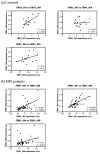Reference Expression Profile of Three FBN1 Transcript Isoforms and Their Association with Clinical Variability in Marfan Syndrome
- PMID: 30754709
- PMCID: PMC6409622
- DOI: 10.3390/genes10020128
Reference Expression Profile of Three FBN1 Transcript Isoforms and Their Association with Clinical Variability in Marfan Syndrome
Abstract
Marfan syndrome (MFS) is a rare connective tissue disorder mainly due to mutations in the FBN1 gene. Great phenotypic variability is notable for age of onset, the presence and absence, and the number and the severity of the symptoms. Our team showed that FBN1 gene expression level was a good surrogate endpoint for severity of some MFS clinical features. Eight alternative transcripts are referenced for the FBN1 gene. We hypothesized that MFS clinical variability could be related to specific FBN1 isoforms. Isoform expression profiles were investigated in skin and adventitial fibroblasts from controls and MFS patients. The results of the study showed that, in skin and adventitial fibroblasts, only three isoforms were found: FBN1_001, FBN1_004, and FBN1_009. The main isoform was FBN1_001 and it was significantly reduced in skin and adventitial fibroblasts of MFS patients. The expressions of FBN1_004 and FBN1_009 isoforms were similar between controls and MFS patients. However, the expression of the three isoforms was correlated only in patients. Furthermore, their expression levels were associated with the presence of ectopia lentis in MFS patients. Therefore, our results highlight that the two minor alternatively spliced FBN1 isoforms play a possible role in the pathogenesis of the disease.
Keywords: Marfan syndrome; alternative splicing; clinical variability; fibrilline-1; isoforms.
Conflict of interest statement
The authors declare no conflicts of interest. The funders had no role in the design of the study; in the collection, analyses, or interpretation of data; in the writing of the manuscript, and in the decision to publish the results.
Figures




Similar articles
-
Genotype and clinical phenotype of children with Marfan syndrome in Southeastern Anatolia.Eur J Pediatr. 2024 Aug;183(8):3219-3232. doi: 10.1007/s00431-024-05579-3. Epub 2024 May 3. Eur J Pediatr. 2024. PMID: 38700693 Free PMC article.
-
Qualitative and quantitative analysis of FBN1 mRNA from 16 patients with Marfan Syndrome.BMC Med Genet. 2015 Dec 18;16:113. doi: 10.1186/s12881-015-0260-4. BMC Med Genet. 2015. PMID: 26684006 Free PMC article.
-
Genotype and phenotype analysis of 171 patients referred for molecular study of the fibrillin-1 gene FBN1 because of suspected Marfan syndrome.Arch Intern Med. 2001 Nov 12;161(20):2447-54. doi: 10.1001/archinte.161.20.2447. Arch Intern Med. 2001. PMID: 11700157
-
Mutations of FBN1 and genotype-phenotype correlations in Marfan syndrome and related fibrillinopathies.Hum Mutat. 2002 Sep;20(3):153-61. doi: 10.1002/humu.10113. Hum Mutat. 2002. PMID: 12203987 Review.
-
A novel fibrillin-1 gene missense mutation associated with neonatal Marfan syndrome: a case report and review of the mutation spectrum.BMC Pediatr. 2016 Apr 30;16:60. doi: 10.1186/s12887-016-0598-6. BMC Pediatr. 2016. PMID: 27138491 Free PMC article. Review.
Cited by
-
Genotype and clinical phenotype of children with Marfan syndrome in Southeastern Anatolia.Eur J Pediatr. 2024 Aug;183(8):3219-3232. doi: 10.1007/s00431-024-05579-3. Epub 2024 May 3. Eur J Pediatr. 2024. PMID: 38700693 Free PMC article.
-
Marfan Syndrome Caused by Disruption of the FBN1 Gene due to A Reciprocal Chromosome Translocation.Genes (Basel). 2021 Nov 21;12(11):1836. doi: 10.3390/genes12111836. Genes (Basel). 2021. PMID: 34828442 Free PMC article.
-
Integrated DNA methylation analysis reveals a potential role for PTPRN2 in Marfan syndrome scoliosis.JOR Spine. 2024 Jan 29;7(1):e1304. doi: 10.1002/jsp2.1304. eCollection 2024 Mar. JOR Spine. 2024. PMID: 38304329 Free PMC article.
-
An enormous Italian pedigree of Marfan syndrome with a novel mutation in the FBN1 gene.Clin Case Rep. 2020 Jun 2;8(8):1445-1451. doi: 10.1002/ccr3.2881. eCollection 2020 Aug. Clin Case Rep. 2020. PMID: 32884772 Free PMC article.
-
Oxidative stress-induced gene expression changes in prostate epithelial cells in vitro reveal a robust signature of normal prostatic senescence and aging.Biogerontology. 2024 Nov;25(6):1145-1169. doi: 10.1007/s10522-024-10126-6. Epub 2024 Aug 20. Biogerontology. 2024. PMID: 39162979 Free PMC article.
References
-
- Collod-Béroud G., Béroud C., Adès L., Black C., Boxer M., Brock D.J., Godfrey M., Hayward C., Karttunen L., Milewicz D., et al. Marfan Database (second edition): software and database for the analysis of mutations in the human FBN1 gene. Nucleic Acids Res. 1997;25:147–150. doi: 10.1093/nar/25.1.147. - DOI - PMC - PubMed
-
- Becerra-Muñoz V.M., Gómez-Doblas J.J., Porras-Martín C., Such-Martínez M., Crespo-Leiro M.G., Barriales-Villa R., de Teresa-Galván E., Jiménez-Navarro M., Cabrera-Bueno F. The importance of genotype-phenotype correlation in the clinical management of Marfan syndrome. Orphanet J. Rare Dis. 2018;13:16. doi: 10.1186/s13023-017-0754-6. - DOI - PMC - PubMed
-
- Faivre L., Collod-Beroud G., Loeys B.L., Child A., Binquet C., Gautier E., Callewaert B., Arbustini E., Mayer K., Arslan-Kirchner M., et al. Effect of mutation type and location on clinical outcome in 1,013 probands with Marfan syndrome or related phenotypes and FBN1 mutations: An international study. Am. J. Hum. Genet. 2007;81:454–466. doi: 10.1086/520125. - DOI - PMC - PubMed
Publication types
MeSH terms
Substances
LinkOut - more resources
Full Text Sources
Medical

